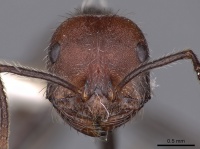Ocymyrmex okys
| Ocymyrmex okys | |
|---|---|

| |
| Scientific classification | |
| Kingdom: | Animalia |
| Phylum: | Arthropoda |
| Class: | Insecta |
| Order: | Hymenoptera |
| Family: | Formicidae |
| Subfamily: | Myrmicinae |
| Tribe: | Crematogastrini |
| Genus: | Ocymyrmex |
| Species: | O. okys |
| Binomial name | |
| Ocymyrmex okys Bolton & Marsh, 1989 | |
Nothing is known about the biology of Ocymyrmex okys.
Identification
A member of the weitzeckeri group. The species closest related to okys is Ocymyrmex monardi, a taxon known from Namibia and Angola; both species belong in the weitzekeri-group. O. monardi is however a more slender species than okys, having the petiole and postpetiole longer than broad in dorsal view, and the petiole node lower and more shallowly convex in profile. Apart from this monardi is more uniformly coloured, not having the head and gaster strongly contrasting with the alitrunk as in okys. (Bolton and Marsh 1989)
Keys including this Species
Distribution
Distribution based on Regional Taxon Lists
Afrotropical Region: Namibia (type locality).
Distribution based on AntMaps
Distribution based on AntWeb specimens
Check data from AntWeb
Countries Occupied
| Number of countries occupied by this species based on AntWiki Regional Taxon Lists. In general, fewer countries occupied indicates a narrower range, while more countries indicates a more widespread species. |

|
Estimated Abundance
| Relative abundance based on number of AntMaps records per species (this species within the purple bar). Fewer records (to the left) indicates a less abundant/encountered species while more records (to the right) indicates more abundant/encountered species. |

|
Biology
|
Castes
Nomenclature
The following information is derived from Barry Bolton's Online Catalogue of the Ants of the World.
- okys. Ocymyrmex okys Bolton & Marsh, 1989: 1299 (w.q.) NAMIBIA.
Unless otherwise noted the text for the remainder of this section is reported from the publication that includes the original description.
Description
Worker
Holotype. TL 7.5, HL 1.84, HW 1.72, CI 93, SL 1.52, SI 88, PW 1.10, AL 2.26.
Palp formula 3, 3, the left apical maxillary palpomere constricted near its midlength. Anterior clypeal margin with a conspicuous median notch or impression. With the head in full-face view the eyes distinctly failing to break the outline of the sides; the maximum diameter of the eye 0.22 x HW. Sides of head in front of eyes straight to extremely feebly concave; behind the eyes rounding into the occipital corners. Occipital margin with a shallow median indentation. Pronotum and anterior mesonotum evenly shallowly convex in profile, posterior portion of mesonotum sloping to the propodeum, the latter itself gently sloped posteriorly and rounding broadly and evenly into the steeply sloping declivity. Metapleural lobes rounded but prominent, in profile projecting beyond the bulge of the metapleural gland bulla and plainly visible. Petiole node relatively large and rounded in profile, in dorsal view slightly broader than long and distinctly broader than the posterior petiolar peduncle. Postpetiole broader than long, narrow anteriorly and rapidly broadening behind, the widest point just behind the midlength. First gastral segment constricted basally, the first tergite much longer than broad. Sculpture of cephalic dorsum coarse and dense. Behind the frontal lobes, and spanning the midline, is a longitudinal strip of irregular rugulae. The outer rugulae of the strip diverge posteriorly and arch outwards behind the eyes, becoming fainter laterally and tending to become confused with strong punctulate-granular ground-sculpture in this area. Between the eye and the antennal fossa on each side the sculpture is of fine dense irregular to chaotic rugulae, whose trend tends to be along an oblique line running towards the mandibular insertion. Sides of alitrunk densely and quite regularly costate to costate-rugose. Side of pronotum with more than 15 oblique longitudinal costae between the ventral margin and the level of the base of the mesothoracic spiracle. Petiole and postpetiole mostly very finely and faintly reticulate to reticulate-granular, in dorsal view the petiole anteriorly with faint and extremely fine transverse rugulae; the ventral surface with some stronger transverse rugulae. Pilosity moderately dense everywhere but sides of meso- and metapleuron without abundant outstanding pilosity. Head dull reddish, the petiole, postpetiole and gaster approximately the same colour or slightly lighter. Alitrunk blackish, in places with a very weak dull, reddish tint.
Paratypes. TL 6.3-7.3, HL 1.70-1.78, HW 1.60-1.65, CI 93-94, SL 1.48-1.56, SI 93-94, PW 1.04-1.07, AL 2.14-2.20 (2 measured). As holotype but somewhat smaller and the eyes marginally larger, maximum diameter 0.23 x HW.
Type Material
Holotype worker, Namibia: Windhoek, 1987, sample WHI (A.C. Marsh) (The Natural History Museum). Paratypes, 2 workers and 1 ergatoid female with same data as holotype (BMNH).
References
- Bolton, B. and A. C. Marsh. 1989. The Afrotropical thermophilic ant genus Ocymyrmex (Hymenoptera: Formicidae). Journal of Natural History. 23:1267-1308. (page 1299, worker, queen described)
References based on Global Ant Biodiversity Informatics
- Bolton B., and A. C. Marsh. 1989. The Afrotropical thermophilic ant genus Ocymyrmex (Hymenoptera: Formicidae). Journal of Natural History 23: 1267-1308.


